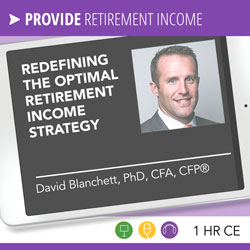David M. Blanchett, PhD, CFA, CFP®, Head of Retirement Research, PGIM DC Solutions
Editor’s note: This article is an adaptation of the live webinar delivered by David Blanchett in 2024. His comments have been edited for clarity and length.
You can read the summary article here as part of the January 2024 Retirement InSight and Trends Newsletter, worth 1.0 CE when read in its entirety (after passing the online quiz.)
You may also choose to take the full length course Redefining the Optimal Retirement Income for 1.0 hour continuing education (CE) credit.
By David M. Blanchett, PhD, CFA, CFP®, Head of Retirement Research, PGIM DC Solutions
Today’s topic is one of the things that I have been researching for over a decade. My goal is to help you think more deeply about how you provide advice and guidance to your clients using financial planning tools.
You are doing a Monte Carlo simulation for a client when you create a financial plan using eMoney, MoneyGuidePro, or any of the leading financial planning software tools. It is not that I dislike Monte Carlo. I love Monte Carlo. It was a fantastic evolution in our industry. The tools we are using and the methodologies for Monte Carlo have not evolved much over the last 30 years since some of the earliest research on things like safe withdrawal rates.
I will walk through some models that could be used in financial planning tools to provide better advice and guidance on anything that you are modeling in a financial plan. I know they work because I have built tools that use them. The good and bad news here is that I do not have anything to sell you.
I don’t expect you to go out and change how you do things tomorrow. Still, by following a framework, we can improve how we give people advice and guidance when it comes to every financial decision that is part of a financial plan. If you want to get more into some of the math behind this presentation, I have an open-access paper you can find online.
There are decades of research backing up this. When I was trying to get this paper published, the reviewers commented that what I covered was not especially novel, but I tied together different models to solve this problem comprehensively. For those of you who know about the research out there, you will see many similarities, but the goal here was a comprehensive framework that gives individuals who want to build tools the chance to figure out how to do so effectively.
Where We Are Today
How many planners use Monte Carlo projections for their clients? It’s about 80% or more.
People define Monte Carlo differently. When I think about Monte Carlo, it is just acknowledging the uncertainty in any projection. You could do two or three runs. You could do 100,000 runs. Whatever it is, that is fine. The key is that we do not know the future, so how can we model it?
Monte Carlo can do anything. The existing limitations will be in the tools that we are using that deploy some kind of stochastic process. Our tools take shortcuts, and the most common shortcut today is this idea of static decision-making.
Assume someone is going to spend $50,000 a year when they retire. They will increase that amount every year by inflation, and that is it. There is no notion of adjusting the spending level or the withdrawal amount based on how things change over time. If you apply things like guardrails, that would be a dynamic model. There are more tools today that are offering some guardrail perspective on retiree spending. Why dynamic withdrawals are so important is not because we can forecast exactly how someone will change in the future based upon the markets; it is because they affect what I would do today.
If I acknowledge that as situations change, I will change, it can significantly affect what I should do right now. An example here would be, should I buy an annuity? If you assume you can only buy the annuity today, the annuity could look incredibly valuable. If you allow for the possibility of buying the annuity at future points in time, you might not have to buy it today. If you acknowledge the possibility of cutting back on spending in the future, it might allow you to spend more money today.
Today’s tools do not allow for this. Most tools today assume that you retire, start the car, throw on blinders, and go down the road. They do not allow you to course-correct, make changes, speed up, or slow down. You follow this same path, and either you succeed or you fail.
The Most Common Metric Today is Success Rates
The overwhelmingly most common metric today for quantifying how people are doing for retirement is success rates. A success rate is pretty simple. You do a Monte Carlo projection. Within each run or trial, you ask, did I accomplish my entire goal? If I accomplished my goal in 800 of 1,000 runs in its entirety, I would have an 80% success rate.
The obvious problem with metrics like these is that they need to pay more attention to the magnitude of failure. Here is an example of a retiree with a need for $50,000 a year of income, and in the 30th year of retirement, they fall just a tiny bit short.
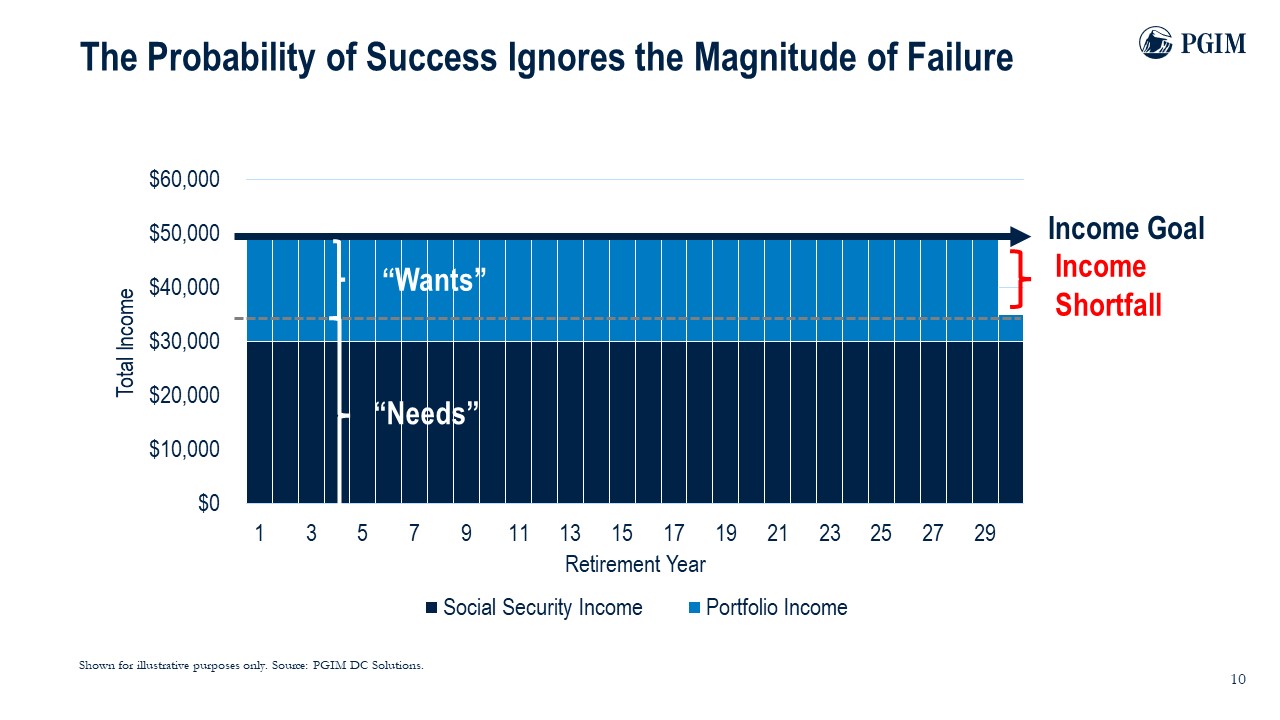
Did this person succeed or fail? They succeeded. Yes, they had this little, tiny blip at the end, but they got all the way there. There is no notion of getting “almost all the way” when you use success rates.
Retiree Spending Flexibility Varies
The four percent rule is the initial withdrawal rate.
What concerns me about it and a lot of the research that has followed is that it uses similar assumptions to what people commonly use in financial plans today. We will call it 30 years old. We should have better models than retirement, which lasts a fixed period, and the income goal increases yearly by inflation, regardless of what else is going on, and outcomes are determined using success rates. This is what Bill Bengen used 30 years ago, and I am going to guess most of you are still using it today to think about retirement outcomes.
This is problematic because it ignores the idea of a “soft liability.” Many of the frameworks we use in the retirement income planning space come from pension plans that use liability-driven investing to plan the payments they are obligated to make. The pension plan does not have a choice. They have a hard liability. They owe some number of beneficiaries and participants millions of dollars a month every month. Remember, they do not have a choice. The thing about people, though, is that people have a choice. They have the capacity to cut back on spending.
How much are retirees willing to cut back on different types of expenditures? You can see the list of expenditures below. Fun fact: these are the primary baskets used to calculate the Consumer Price Index.
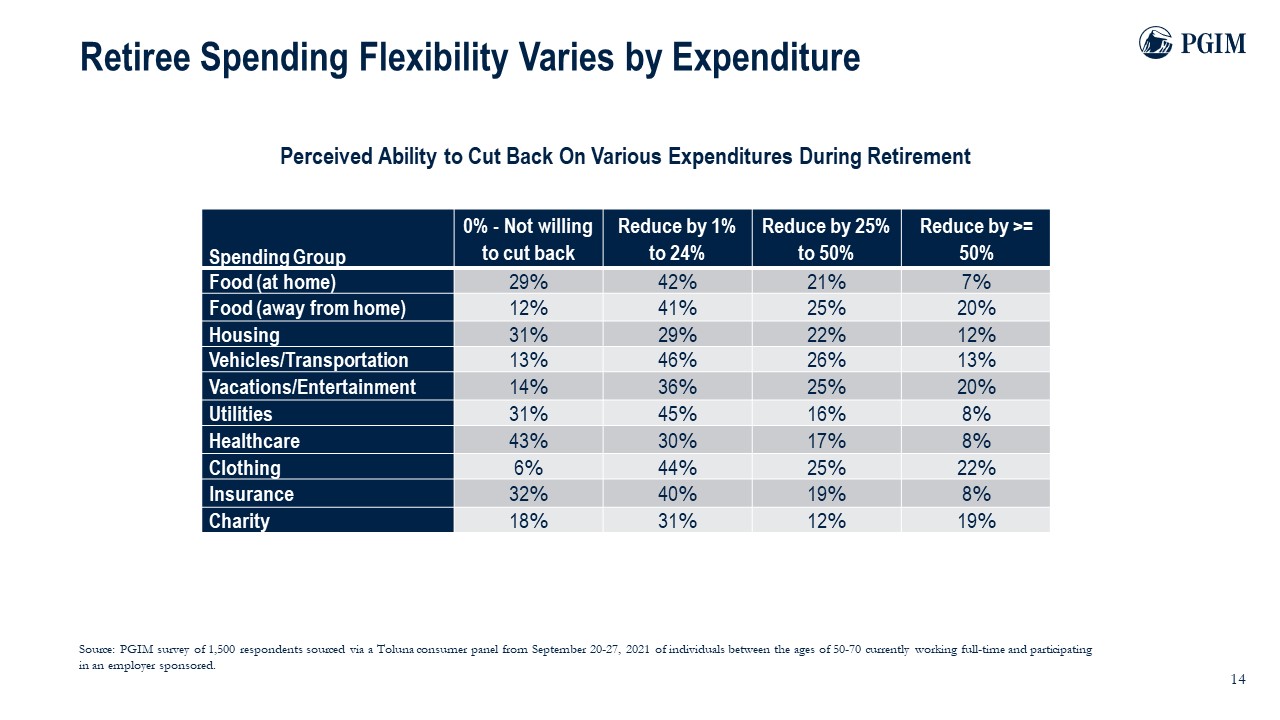
If you think about success rates and static modeling, the assumption is that every single person – 100% of respondents – would not be willing to cut back at all on any expenditure. However, that’s not the case. There are certain types of expenditures like healthcare that people are less willing to cut back on. But even then, 57% of respondents are willing to reduce healthcare costs. They might not love it, but they are willing to do so, right? Look at things like food away from home. Only 12% of respondents are unwilling to cut back on food away from home.
Why this is so important? It is all about tradeoffs. Most retirees are not spectacularly overfunded. They want to use their money. \”I would love to go on this vacation or this cruise or go to Italy when I am 67. Can I afford to do it?\” Well, you must ask them in a plan whether the tradeoff is worth doing so. What does it mean for your income tomorrow if you take that today? The key here is not assuming the income tomorrow is zero because it will not be zero.
Where could things go if you model the reasonable approaches someone could take to changing their spending versus just if even a penny short after the 30th year is a failure? You can ask this in different ways. Here is a great way to ask: “So, what is the impact of a 20% drop on your retirement lifestyle?” In reality, people can afford to make this work.
Flexibility in spending allows for someone to think about those kinds of tradeoffs. How would I respond to a possible drop? Am I okay with it? Today\’s retirement planning software does not generally allow for modeling this. They assume you would follow the same path, and you have failed if you fall just short.
This notion of flexibility, though, is essential for your clients, given the composition of their retirement liability. Below is the percentage of spending that would be defined as essential or non-discretionary or needs by household spending level.
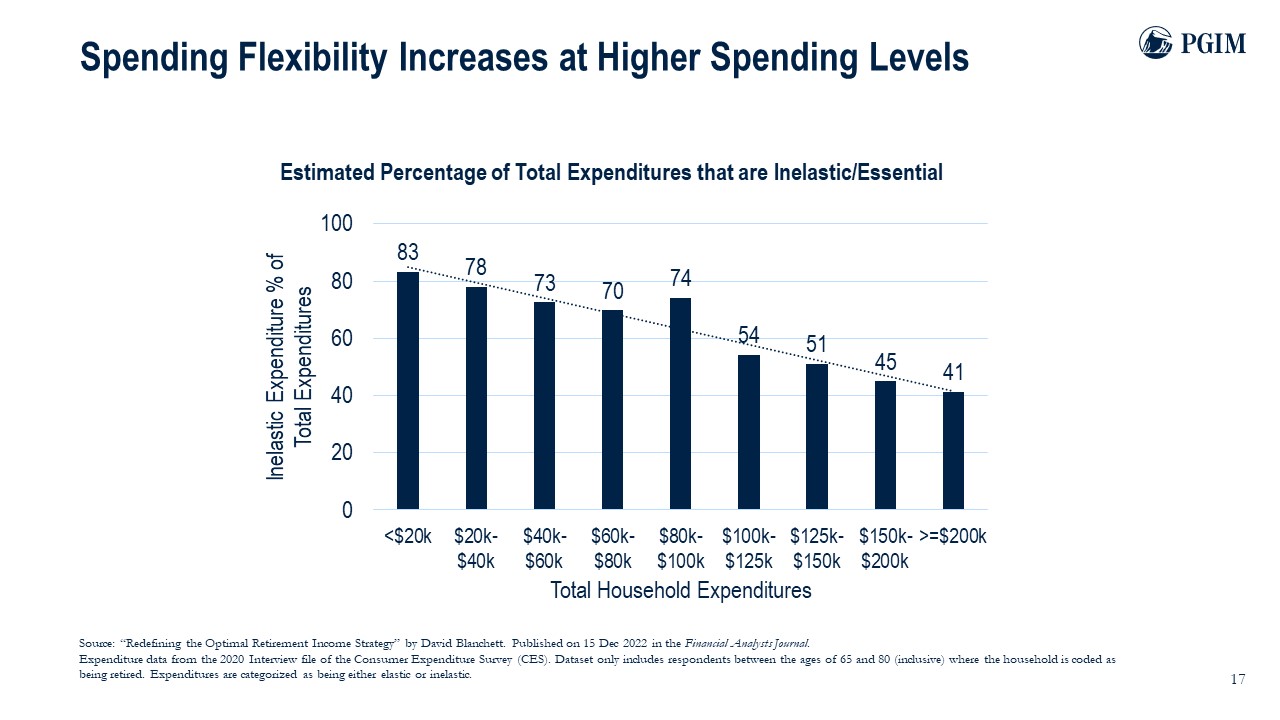
This is incredibly intuitive. The more that a household spends, the more they tend to spend on items that are more flexible or discretionary in nature. Your clients will have more income in general and could cut back on discretionary spending if needed.
Should this ability to cut back on spending when needed change how you allocate their portfolio? This is an example of thinking about mapping household assets. I am using the word “assets” here holistically.
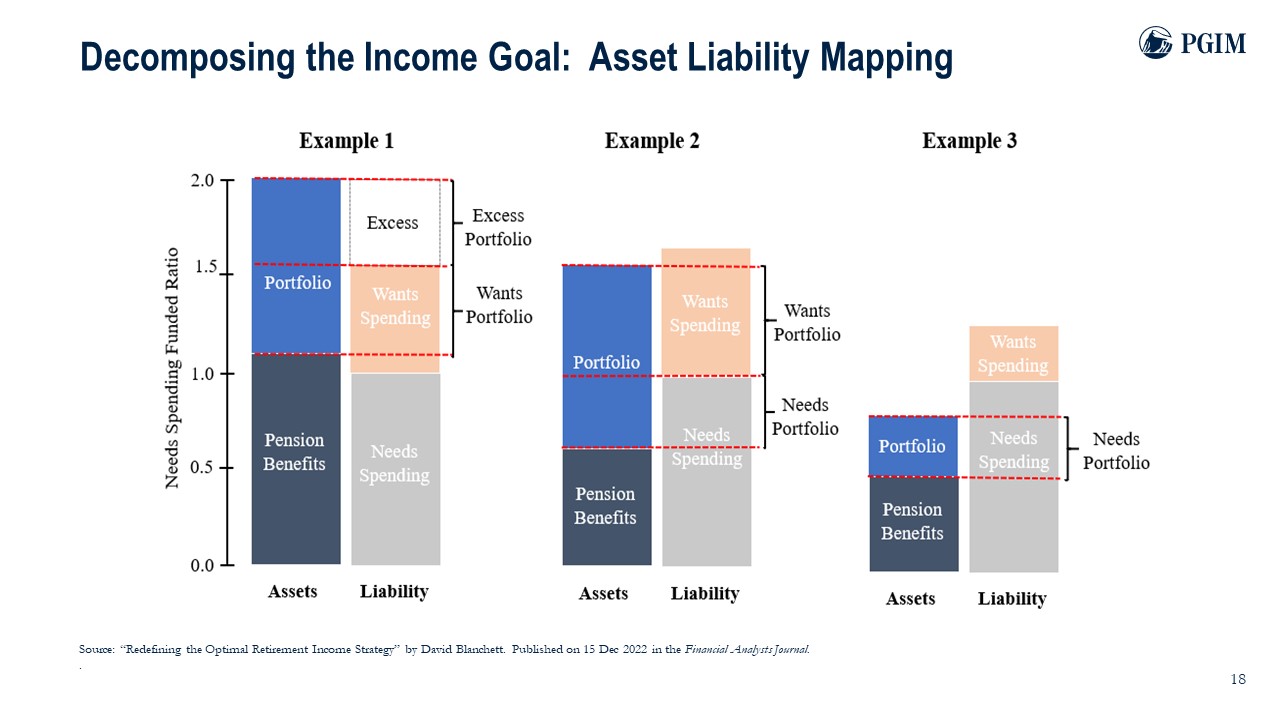
Think about the net present value of Social Security or just the income you derive from it and the portfolio; map that against what it is actually funding. A lot of you might use buckets or time segmentation. That is one example here. Another way to think about buckets would be segmenting not only assets based on time but also the type of spending that will be funded with it.
A portfolio that will fund needs or essential expenditures should be invested differently than one that is more flexible because the roles of portfolios are very different, right? I have done much research on this. One is when you allow for spending flexibility in retirement, you can get a very different perspective on what the correct allocation to risky assets is. What you see is that the more flexible the spending goal is, the higher you can allocate your risky assets, as allocating more to stocks will, on average, create better outcomes if we assume that stocks, again, outperform bonds on average.
A More Realistic Retirement Spending Model
Now, let us talk about how we start to model retirement income. The slide below shows an example of individual runs from a Monte Carlo projection that assumes static withdrawal. So, the four percent rule. I take out a number; I increase it by inflation. I do so for 30 years. Okay.
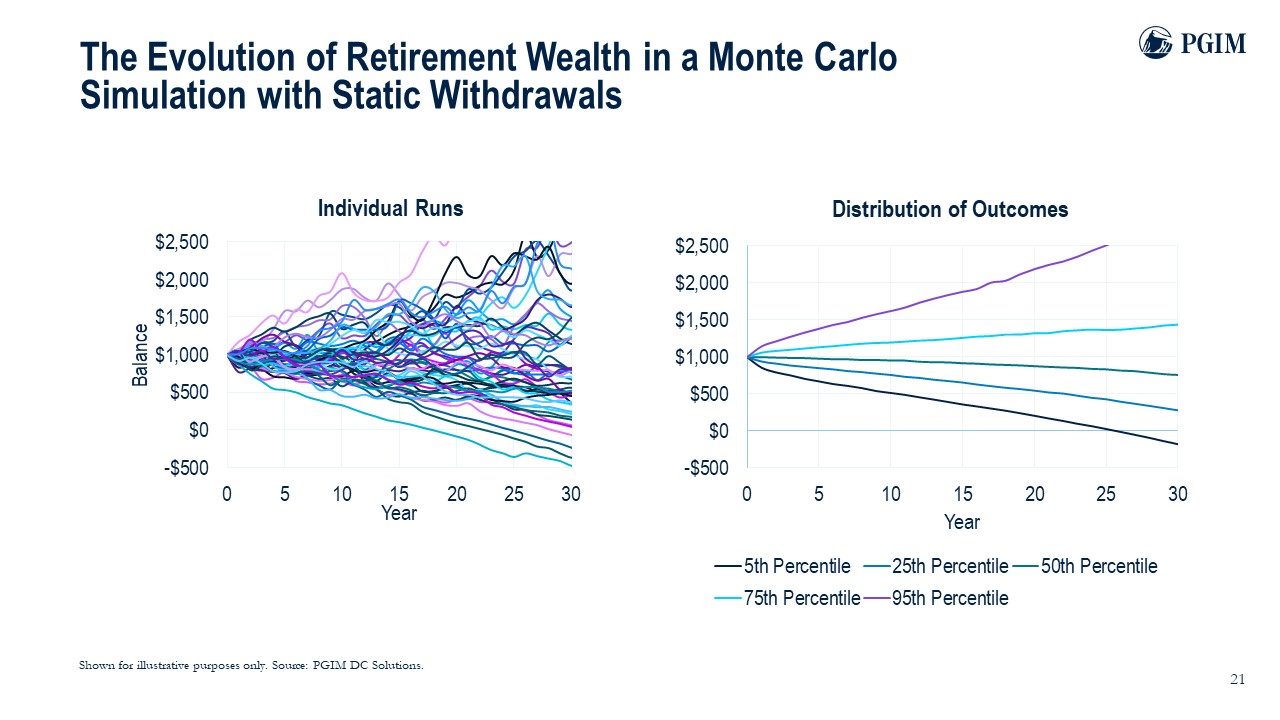
The individual runs are a single Monte Carlo projection. What happens, though, is that it massively diverges over time because it does not assume that you course-correct at all. Some are headed towards failure after the market drops 20% or 30% because they still spend $40,000 a year. That is not realistic. There are some scenarios where you still spend $40,000 yearly, but we have a 10-year bull market.
It is unrealistic because it does not attract the decisions that most people would make when confronted with these market outcomes. It leads to a situation where you will have more wealth on average in death in today’s dollars than you did when you first retired. If you look at the distribution of outcomes for the four percent rule, especially now using higher capital market assumptions, it could be more efficient. If you aim to maximize your lifetime income from a portfolio, you will not follow a static strategy.
You would dynamically adjust that spending amount yearly based on how things evolve. How is your portfolio doing? How is your life expectancy changing? Given those variables, you would make significant adjustments over time. The key here is changing the definition of failure. I have seen some research about how two percent is the new four percent regarding safe withdrawal rates because it uses age 105 as the retirement end age, targeting a 99% success rate. What is the point of that?
Suppose you run a Monte Carlo projection and include incredibly conservative assumptions. In that case, you are effectively saying there is an incredibly low chance you would ever have to make a change, so you cannot spend anything today. You will spend half of what you could under more realistic assumptions. That is not an accurate reflection of the tradeoffs people want to make. This is a risk that no one talks about: the risk that you spend too little right now and you have too much leftover when you are 85 or 90 years old. It is a different kind of risk, where you do not get to enjoy what you saved for. The advisors say, no, no, no, you cannot take that cruise because you must have a 99% success rate. That is ridiculous, right?
It is this idea of, again, flexible spending. Dynamic models allow for this. They assume people make adjustments to their spending based on some series of rules. For better or for worse, we see little of them in financial planning tools today. In my opinion, the models that are in most of them are not very good for two reasons.
- They cannot handle nonconstant cashflows. Say that the portfolio is doing poorly, and you will get this massive inflow, like an inheritance, in 10 years. The software cannot account for that.
- Another issue with dynamic withdrawals is just computational timing. Some of the more exotic methodologies can take minutes to run. Planners do not have time for that.
So, this combination of rules that do not work well with uneven cashflows and timing issues resulted in most planning tools not using them today.
In terms of dynamic models, though, one of the easiest and best ones is the modified RMD rule. It\’s pretty simple, though it is not perfect. It is one over what you define as your retirement planning period. You should also use a personalized estimate for retirement planning periods versus the IRS tables.
What this does is it results in a withdrawal rate that varies as the retiree moves through retirement. The problem with the four percent rule is that it is irrelevant if you are 85 years old and single. Approaches like this give you a better perspective on how that spending could evolve as you retire. If you recall earlier, the projection that used static withdrawals, the runs diverged over time. They explode because it does not assume any kind of course correction. When you use dynamic methodology, it converges. It assumes that you are spending down your wealth appropriately given your expected final time horizon.
I did mention that most dynamic models do not work if you think about uneven cash flows. If we go back to the approach where I assume that I will change spending based on portfolio returns, how does that factor in, for example, the fact that I might retire at 60 and claim Social Security at 70?
Your withdrawal rate should be much higher, from ages 60 to 70, and then decrease when you receive your Social Security. But it does not work if you focus only on market returns, right? How does it address deferred income annuity or longevity insurance peaking at age 80?
What is most effective at determining whether someone should make a change in their income is their complete financial picture. Holistically, their assets are defined as the portfolio and things like future expected income. Their funded ratio is the value of their assets divided by their retirement liability or the sum of all current and future expected spending. A funded ratio of 1.0 implies that an individual has just enough assets to fund their retirement goal fully. A ratio greater than 1.0 implies a surplus of assets, while a ratio of less than 1.0 implies a shortfall. Each year, you can total all the retirement assets and liabilities and figure out how someone’s situation is evolving over time. If the portfolio decreases in value, the funded ratio should decrease. If it goes up, the funded ratio should go up.
Let’s say a retiree spends $100,000 a year and possibly increases or decreases that in today’s dollars based on how their funded ratio changes. And this is an example of what that income path could look like.
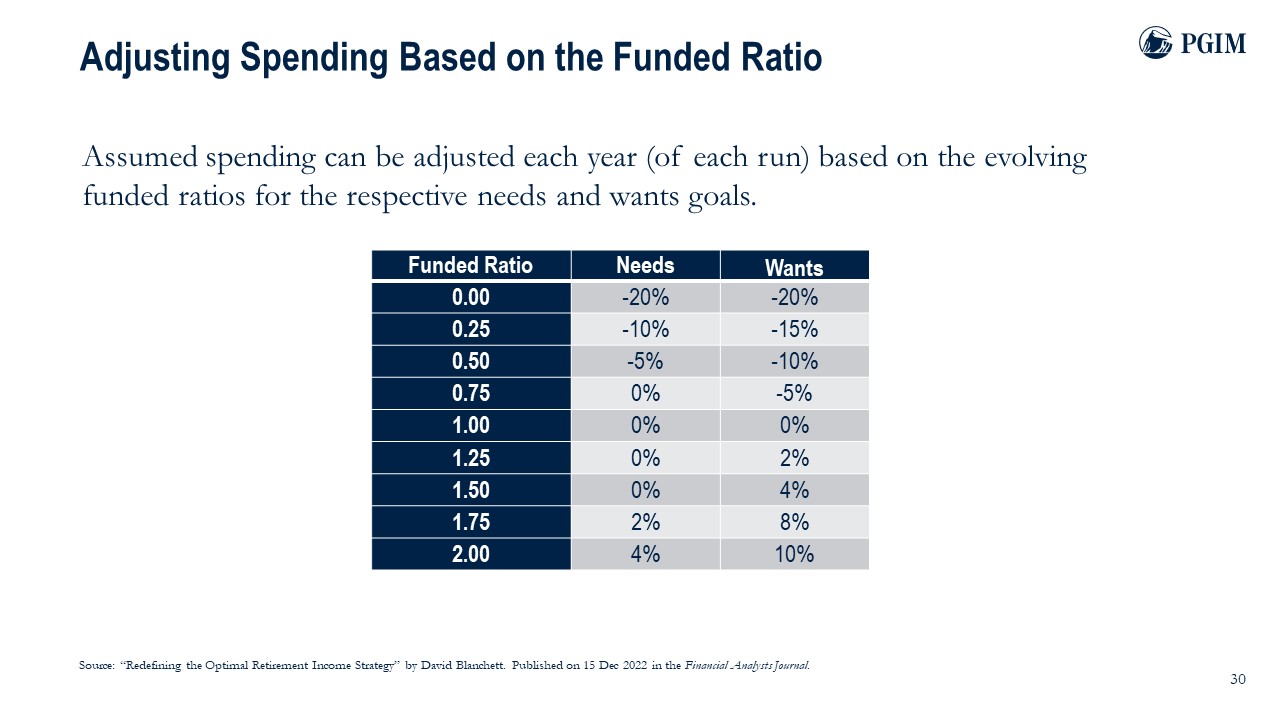
More income is possible over time if the markets do well. There is a possibility of less income if the markets misbehave. This is a different perspective than you might fail and have no money in 30 years.
I like this idea of dynamic withdrawals because it gives someone perspective. Telling them, hey, in the worst 1 in 4 outcomes, you might have $75,000 a year of income. How does that make you feel? This tracks how someone would make changes over time based on market performance. You cannot get that with the static methodology. Either you will achieve the entire goal or effectively none of it.
Many advisors think they are already doing dynamic planning. Each year, they tell their clients this is how much they should spend. The problem is that their planning tools are not factoring this in. When you factor dynamic planning in and model these changes you would make, it affects what you would do today. There is a big disconnect.
Now What?
Say I use success rates as my outcomes metric and accomplish my goal in half of them; I have a 50% success rate. But using the same analysis, you could also accomplish an average of 96% of the spending goal. Think about how different that is—a 50% success rate where you accomplished 96% of the spending goal.
Success rates are a series of ones and zeros, meeting the goal or not. If you instead look at this idea of goal completion, then think about if you still need to accomplish your goal; how short am I? When you start to use dynamic methodologies, however, you really cannot use success rates because a success rate evaluates whether you accomplished the goal.
We can do a better job quantifying outcomes and success rates in our industry. It is a very low lift for every single software platform out there. The next step forward is just goal completion. Instead of looking at the run itself and assigning a one if they accomplish the goal or a zero if they don’t, estimate the percentage of the goal they accomplish.
In addition, we need to stop telling clients the numbers themselves, especially success rates. An 80% success rate is a good target. If I am going to relay information to a client, do not tell them they have an 82% success rate. What is useful is, “You are on track; come back again next year.” Right?
About David M. Blanchett, PhD, CFA, CFP®, Head of Retirement Research, PGIM DC Solutions
David Blanchett, CFA, CFP®, AIFA, is the head of retirement research for PGIM DS Solutions. He works to enhance the group’s consulting and investment services. David conducts research primarily in the areas of financial planning, tax planning, annuities, and retirement plans and he serves as the Chairman of the Advice Methodologies Investment subcommittee.
David’s research has been published in a variety of academic and industry journals and has been featured in a variety of media publications. In 2014 Money Magazine named him one of the five brightest minds in retirement and in 2014 Investment News included him in their inaugural 40 under 40 list as a “visionary” for the financial planning industry.
He is part of group of retirement thought leaders – truly a breath of fresh air – along with Wade Pfau, Michael Finke and others, who challenge us to go beyond targeting 80% replacement rates, traditional retirement portfolio asset allocations, inflation-adjusted systematic withdrawals of 4% and probabilities of success or failure.
Are you looking for a retirement speaker for your next conference, consumer event or internal professional development program? Visit the Retirement Speakers Bureau to find leading retirement industry speakers, authors, trainers and professional development experts who can address your audience’s needs and budget.
©2024, David M. Blanchett, PhD, CFA, CFP®, Head of Retirement Research, PGIM DC Solutions. All rights reserved. Used with permission.


